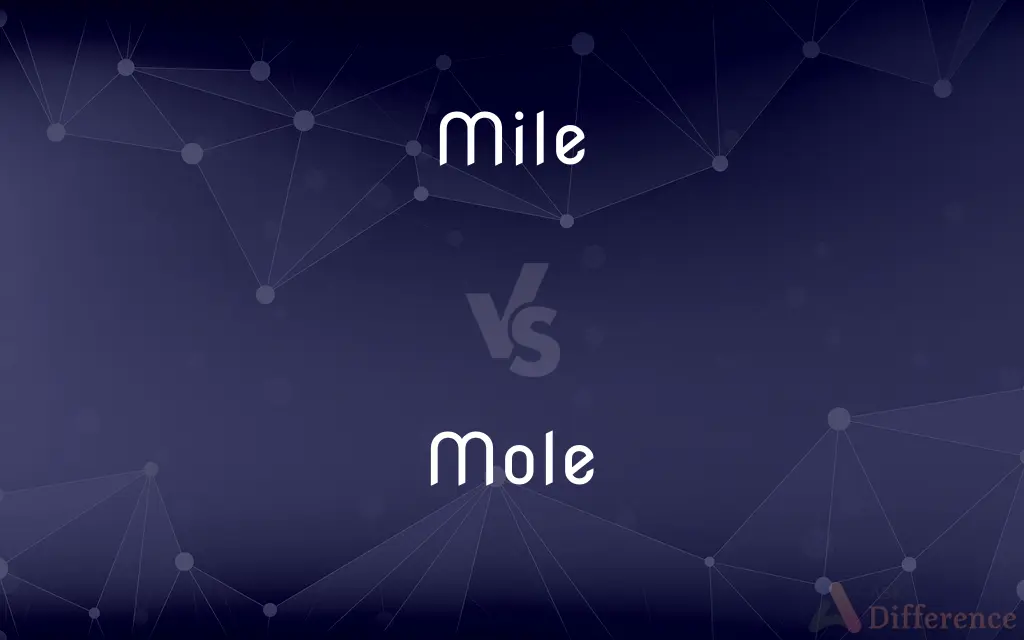Mile vs. Mole — What's the Difference?
By Tayyaba Rehman & Urooj Arif — Updated on April 25, 2024
A mile is a unit of distance measurement (1,760 yards), while a mole is a unit for measuring chemical substances based on Avogadro's number.

Difference Between Mile and Mole
Table of Contents
ADVERTISEMENT
Key Differences
A mile is primarily used in measuring distances, particularly in countries like the United States and the United Kingdom. On the other hand, a mole is a fundamental concept in chemistry for quantifying atoms, molecules, or ions in a given sample.
The mile has a standardized length of approximately 1,609 meters or 5,280 feet. In contrast, a mole represents approximately 6.022 x 10^23 particles of a substance, a number known as Avogadro's number.
Usage of the mile is common in everyday contexts, such as in road signage and in discussing travel distances. Whereas, the mole is used in scientific contexts, especially in stoichiometry and chemical equations.
The understanding of a mile can be intuitive and related to real-life travel experiences. Conversely, the concept of a mole requires an understanding of atomic and molecular scales, which are not directly observable.
While the mile is an older unit of measurement with roots in Roman and British imperial systems, the mole was adopted as part of the International System of Units (SI) in the 20th century, reflecting its scientific utility.
ADVERTISEMENT
Comparison Chart
Definition
Unit of linear measure equal to 5,280 feet or 1,609 meters
Unit of measurement in chemistry for amount of substance
System of Measurement
Imperial and US customary systems
International System of Units (SI)
Common Usage
Distance measurement in navigation and transport
Quantifying particles in chemical processes
Numeric Value
Fixed (1 mile = 5,280 feet or 1,609 meters)
Variable (depends on substance, based on Avogadro's number)
Basis of Measurement
Historical development based on practical travel distances
Scientific standard based on constants
Compare with Definitions
Mile
A unit of length equal to 5,280 feet.
The park is just a mile down the road.
Mole
Universal in scientific calculations.
The reaction yielded 0.5 moles of sodium chloride.
Mile
Used primarily in the United States and the UK.
He ran a four-minute mile.
Mole
Based on Avogadro’s number, 6.022 x 10^23.
A mole of water contains Avogadro's number of molecules.
Mile
Historically measured by the Romans.
The ancient roads were measured in miles.
Mole
A chemical unit for amount of substance.
A mole of carbon atoms weighs 12 grams.
Mile
Often used in colloquial expressions.
They live miles away from the city.
Mole
Essential in stoichiometry.
One mole of oxygen reacts with two moles of hydrogen.
Mile
Relates to travel and navigation.
The next rest stop is five miles away.
Mole
Used in teaching fundamental chemistry concepts.
Students learn to calculate the molar mass in their first chemistry class.
Mile
The mile, sometimes the international mile or statute mile to distinguish it from other miles, is a British imperial unit and US customary unit of distance; both are based on the older English unit of length equal to 5,280 English feet, or 1,760 yards. The statute mile was standardised between the British Commonwealth and the United States by the international agreement in 1959, when it was formally redefined with respect to SI units as exactly 1,609.344 metres.
Mole
A small burrowing mammal with dark velvety fur, a long muzzle, and very small eyes, feeding mainly on worms, grubs, and other invertebrates.
Mile
A unit of linear measure equal to 1,760 yards (approximately 1.609 kilometres).
Mole
A spy who gradually achieves an important position within the security defences of a country
A well-placed mole was feeding them the names of operatives
Mile
A very long way or a very great amount
Vistas which stretch for miles
This is my favourite film by a mile
Mole
A small, often slightly raised blemish on the skin made dark by a high concentration of melanin
A mole on her arm had not been there at the beginning of the summer
Mile
By a great amount or a long way
The second tape is miles better
Mole
A large solid structure on a shore serving as a pier, breakwater, or causeway.
Mile
Abbr. mi. or mi A unit of length equal to 5,280 feet or 1,760 yards (1,609 meters), used in the United States and other English-speaking countries. Also called land mile, statute mile. See Table at measurement.
Mole
The SI unit of amount of substance, equal to the quantity containing as many elementary units as there are atoms in 0.012 kg of carbon-12.
Mile
A nautical mile.
Mole
An abnormal mass of tissue in the uterus.
Mile
An air mile.
Mole
A highly spiced Mexican sauce made chiefly from chilli peppers and chocolate, served with meat.
Mile
(Sports) A race that is one mile long.
Mole
A skin lesion, commonly a nevus, that is typically raised and discolored.
Mile
A relatively great distance
Had to walk for miles in the airport.
Mole
Any of various small insectivorous mammals of the family Talpidae of North America and Eurasia, usually living underground and having a thickset body with light brown to dark gray silky fur, strong forefeet for burrowing, and often rudimentary eyes.
Mile
The international mile: a unit of length precisely equal to 1.609344 kilometers established by treaty among Anglophone nations in 1959, divided into 5,280 feet or 1,760 yards.
Turn left in 1.2 miles.
Mole
A machine that bores through hard surfaces, used especially for tunneling through rock.
Mile
Any of several customary units of length derived from the 1593 English statute mile of 8 furlongs, equivalent to 5,280 feet or 1,760 yards of various precise values.
Mole
A spy who operates from within an organization, especially a double agent operating against that agent's own government from within its intelligence establishment.
Mile
Any of many customary units of length derived from the Roman mile (mille passus) of 8 stades or 5,000 Roman feet.
Mole
A massive, usually stone wall constructed in the sea, used as a breakwater and built to enclose or protect an anchorage or a harbor.
Mile
The Scandinavian mile: a unit of length precisely equal to 10 kilometers defined in 1889.
Mole
The anchorage or harbor enclosed by a mole.
Mile
Any of many customary units of length from other measurement systems of roughly similar values, as the Chinese (里) or Arabic mile (al-mīl).
Mole
A fleshy abnormal mass formed in the uterus by the degeneration or abortive development of an ovum.
Mile
(travel) An airline mile in a frequent flyer program.
Mole
In the International System, the base unit used in representing an amount of a substance, equal to the amount of that substance that contains as many atoms, molecules, ions, or other elementary units as the number of atoms in 0.012 kilogram of carbon-12. The number is 6.0221 × 1023, or Avogadro's number. See Table at measurement.
Mile
(informal) Any similarly large distance.
The shot missed by a mile.
Mole
A pigmented spot on the skin, a naevus, slightly raised, and sometimes hairy.
Mile
(slang) A race of 1 mile's length; a race of around 1 mile's length (usually 1500 or 1600 meters)
The runners competed in the mile.
Mole
Any of several small, burrowing insectivores of the family Talpidae; also any of southern African mammals in the family Chrysochloridae (golden moles) and any of several Australian mammals in the family Notoryctidae (marsupial moles), similar to but not closely related to Talpidae moles
Mile
(slang) One mile per hour, as a measure of speed.
Five miles over the speed limit
Mole
Any of the burrowing rodents also called mole-rats.
Mile
A certain measure of distance, being equivalent in England and the United States to 320 poles or rods, or 5,280 feet.
Mole
(espionage) An internal spy, a person who involves himself or herself with an enemy organisation, especially an intelligence or governmental organisation, to determine and betray its secrets from within.
Mile
A unit of length equal to 1760 yards
Mole
A kind of self-propelled excavator used to form underground drains, or to clear underground pipelines
Mile
A unit of length used in navigation; equivalent to the distance spanned by one minute of arc in latitude; 1,852 meters
Mole
A type of underground drain used in farm fields, in which a mole plow creates an unlined channel through clay subsoil.
Mile
A large distance;
He missed by a mile
Mole
A moll, a bitch, a slut.
Mile
A former British unit of length once used in navigation; equivalent to 1828.8 meters (6000 feet)
Mole
(nautical) A massive structure, usually of stone, used as a pier, breakwater or junction between places separated by water.
Mile
A British unit of length equivalent to 1,853.18 meters (6,082 feet)
Mole
(rare) A haven or harbour, protected with such a breakwater.
Mile
An ancient Roman unit of length equivalent to 1620 yards
Mole
(historical) An Ancient Roman mausoleum.
Mile
A Swedish unit of length equivalent to 10 km
Mole
In the International System of Units, the base unit of amount of substance; the amount of substance of a system which contains exactly 6.02214076×1023 elementary entities (atoms, ions, molecules, etc.). Symbol: mol. The number of atoms is known as Avogadro’s number. from 1897
Mile
A footrace extending one mile;
He holds the record in the mile
Mole
A hemorrhagic mass of tissue in the uterus caused by a dead ovum.
Mole
One of several spicy sauces typical of the cuisine of Mexico and neighboring Central America, especially a sauce which contains chocolate and which is used in cooking main dishes, not desserts.
Mole
A spot; a stain; a mark which discolors or disfigures.
Mole
A spot, mark, or small permanent protuberance on the human body; esp., a spot which is dark-colored, from which commonly issue one or more hairs.
Mole
A mass of fleshy or other more or less solid matter generated in the uterus.
Mole
A mound or massive work formed of masonry or large stones, etc., laid in the sea, often extended either in a right line or an arc of a circle before a port which it serves to defend from the violence of the waves, thus protecting ships in a harbor; also, sometimes, the harbor itself.
Mole
Any insectivore of the family Talpidæ. They have minute eyes and ears, soft fur, and very large and strong fore feet.
Mole
A plow of peculiar construction, for forming underground drains.
Mole
A spy who lives for years an apparently normal life (to establish a cover) before beginning his spying activities.
Mole
A quantity of a substance equal to the molecular weight of a substance expressed in grams; a gram molecule; the basic unit of amount of substance adopted under the System International d'Unites; as, he added two moles of sodium chloride to the medium.
Mole
To form holes in, as a mole; to burrow; to excavate; as, to mole the earth.
Mole
To clear of molehills.
Mole
The molecular weight of a substance expressed in grams; the basic unit of amount of substance adopted under the Systeme International d'Unites
Mole
A spy who works against enemy espionage
Mole
Spicy sauce often containing chocolate
Mole
A small congenital pigmented spot on the skin
Mole
A protective structure of stone or concrete; extends from shore into the water to prevent a beach from washing away
Mole
Small velvety-furred burrowing mammal having small eyes and fossorial forefeet
Common Curiosities
How did the mile get its length?
Its length was standardized based on the historical measures used in England and the Roman Empire.
What is a mile used for?
Primarily for measuring distances in navigation and transportation.
How is a mile defined?
As 5,280 feet or about 1,609 meters.
What does a mole represent in chemistry?
A mole represents an amount of substance that contains as many elementary entities as there are atoms in 12 grams of carbon-12.
Can a mile be used in scientific research?
It's less common but can be used in research involving large-scale geographical studies.
Why is the mole important in chemistry?
It allows chemists to count particles by weighing them, crucial in chemical reactions and formulas.
How does one calculate the number of particles in a mole?
By using Avogadro's number, which is approximately 6.022 x 10^23 particles per mole.
Are there any other units related to the mile?
Yes, such as the nautical mile, which is used in aviation and maritime navigation.
Is the mile the same worldwide?
No, it varies slightly depending on the country, but the international mile is widely used.
What is Avogadro's number?
A constant that represents the number of particles in a mole is 1.
Share Your Discovery

Previous Comparison
Olympiad vs. Olympics
Next Comparison
Craft vs. TradeAuthor Spotlight
Written by
Tayyaba RehmanTayyaba Rehman is a distinguished writer, currently serving as a primary contributor to askdifference.com. As a researcher in semantics and etymology, Tayyaba's passion for the complexity of languages and their distinctions has found a perfect home on the platform. Tayyaba delves into the intricacies of language, distinguishing between commonly confused words and phrases, thereby providing clarity for readers worldwide.
Co-written by
Urooj ArifUrooj is a skilled content writer at Ask Difference, known for her exceptional ability to simplify complex topics into engaging and informative content. With a passion for research and a flair for clear, concise writing, she consistently delivers articles that resonate with our diverse audience.














































